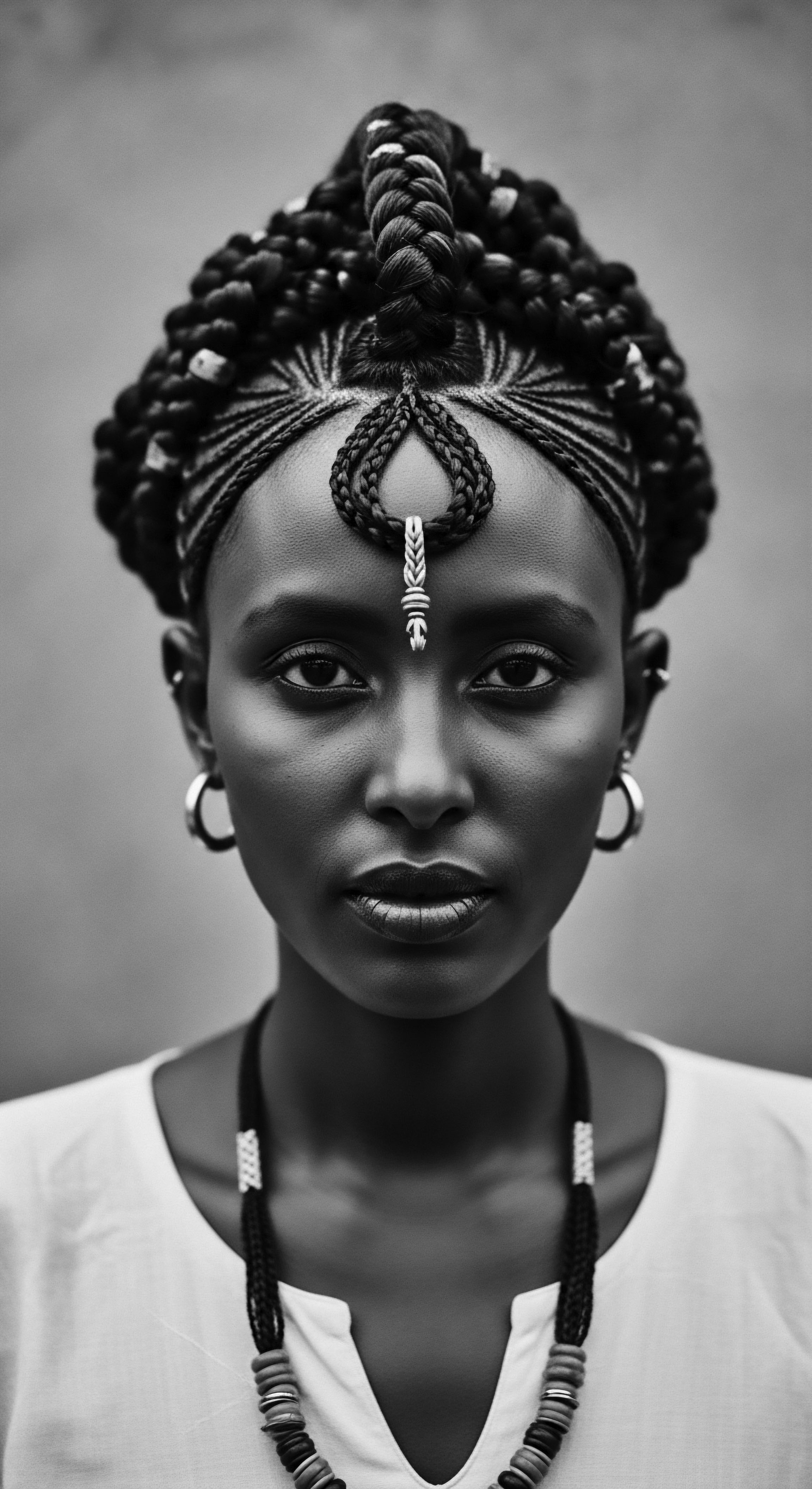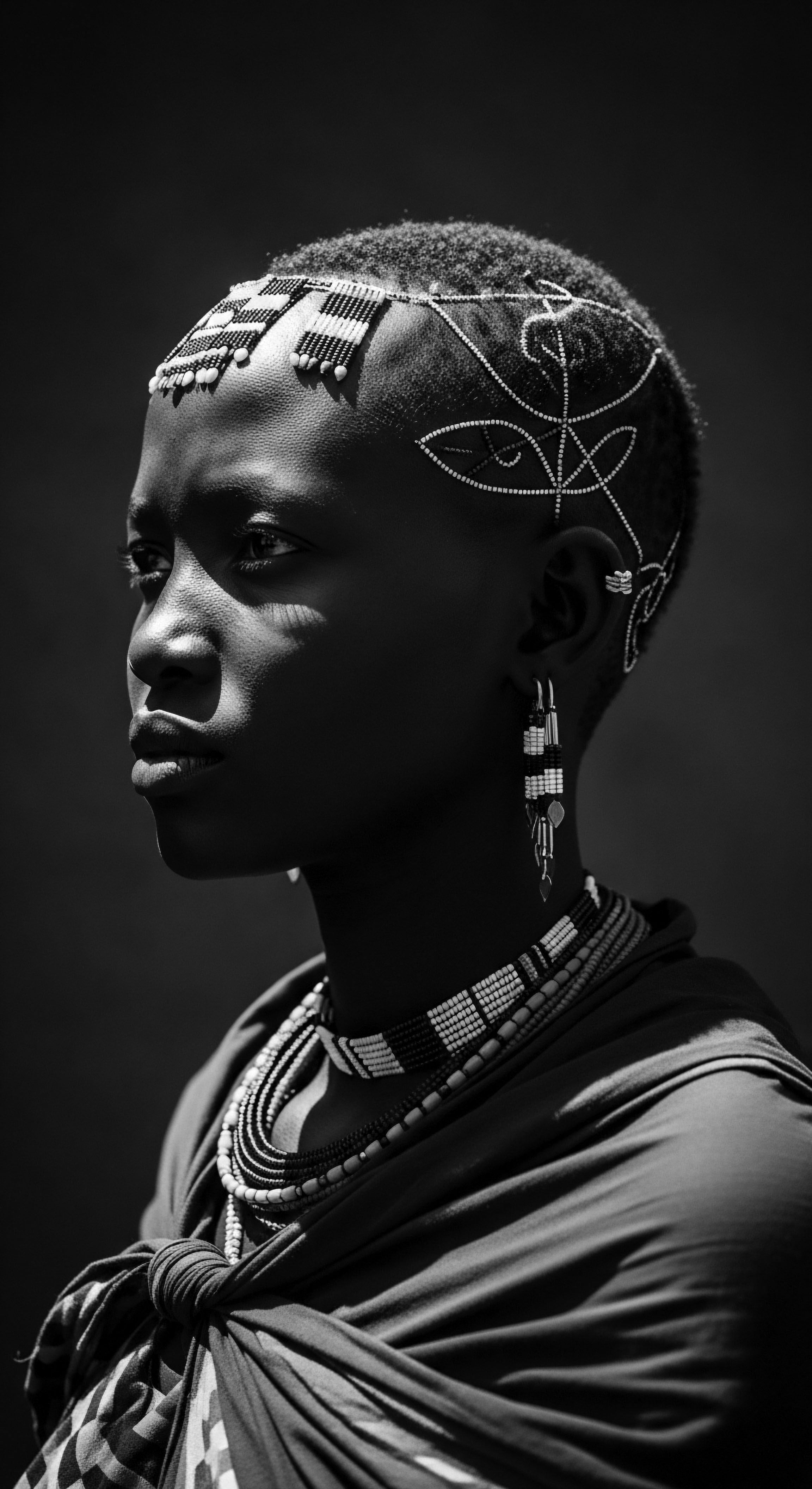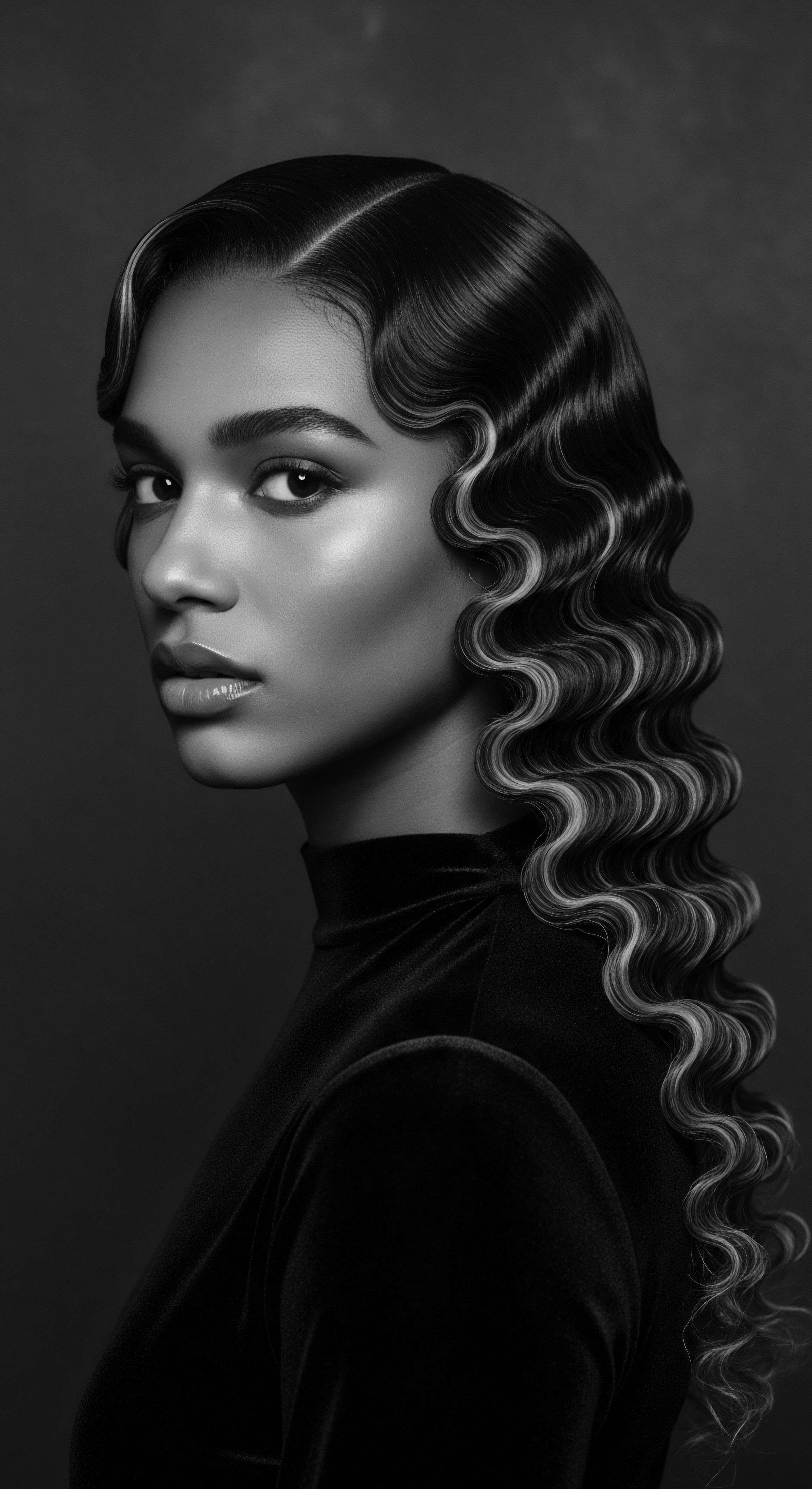
Roots
Consider the deep roots that anchor us to the earth, the very fibers of our being woven from time and ancestry. Just as a mighty tree draws sustenance from the soil its elders nourished, so too does our textured hair carry the wisdom of generations past. Each coil, each curve, speaks a language of resilience, a silent testament to a heritage that stretches back through time, across continents, and into the elemental pulse of life itself.
The inquiry into whether ancestral botanical routines truly enhance textured hair is not a mere question of cosmetic benefit; it is an invitation to rediscover a profound connection, to honor the legacies etched into every strand. This exploration delves into the very biology of our hair, viewed through a lens polished by history and cultural observance, seeking to understand how ancient botanical wisdom intertwines with the molecular structures that define our crowns.

Textured Hair’s Ancient Blueprint
The unique architecture of textured hair, with its elliptical follicle shape and varied curl patterns, distinguishes it from straight hair. This biological specificity dictates how moisture travels along the hair shaft, how light reflects from its surface, and how it responds to environmental elements. For countless millennia, communities across Africa and the diaspora developed intricate care systems that inherently understood these characteristics.
These systems emerged not from laboratory analysis, but from a lived intimacy with the hair, informed by observation, tradition, and an understanding of the botanical world that surrounded them. The very concept of ‘care’ in these contexts was often indistinguishable from rituals of communal identity and spiritual practice.
The profound structural characteristics of textured hair have always guided the botanical practices of ancestral communities.

Botanical Wisdom and Hair Anatomy
Ancestral routines often incorporated specific botanicals that addressed the inherent needs of textured hair ❉ its propensity for dryness, its desire for gentle handling, and its strength when properly supported. These plant-derived remedies were not random choices; they were selections born from sustained observation and generations of experiential wisdom. The knowledge of which plant offered moisture, which provided strength, or which soothed the scalp was passed down, often orally, across matriarchal lines.
The understanding of hair anatomy, while not articulated in modern scientific terms, existed in a practical sense. For example, recognizing that certain oils, like Shea Butter from West Africa or Baobab Oil, sealed moisture into the hair, suggests an intuitive grasp of the hair cuticle and cortex. These ancestral users perceived the hair’s porous nature and its requirement for protective layering, crafting routines that sealed the hair shaft.
| Ancestral Botanical Shea Butter (Vitellaria paradoxa) |
| Traditional Application for Textured Hair Moisture retention, softness, scalp conditioning in West African communities. |
| Modern Scientific Link to Hair Structure Rich in fatty acids (oleic, stearic) that coat the hair shaft, reducing water loss and increasing flexibility. |
| Ancestral Botanical Baobab Oil (Adansonia digitata) |
| Traditional Application for Textured Hair Nourishment, protection from sun, general hair health, often across various African regions. |
| Modern Scientific Link to Hair Structure Contains antioxidants and essential fatty acids, potentially supporting cuticle health and providing environmental shielding. |
| Ancestral Botanical Henna (Lawsonia inermis) |
| Traditional Application for Textured Hair Conditioning, strengthening, and color enhancement, particularly in North Africa and the Middle East. |
| Modern Scientific Link to Hair Structure Lawsone molecules bind to keratin, strengthening the hair shaft and reducing breakage. |
| Ancestral Botanical These ancestral choices reflect a sophisticated understanding of hair needs, often validated by contemporary biological inquiry. |

How Did Ancient Practices Inform Hair Understanding?
The terminology for hair types and conditions within ancestral communities was deeply cultural, often intertwined with identity, status, and spiritual beliefs. While modern classification systems for textured hair have evolved, some inadvertently carrying historical biases, ancestral lexicons offered a different kind of precision. They described hair not merely by its curl pattern, but by its vitality, its response to care, and its symbolic weight within the community.
The act of washing hair with Yucca Root, practiced by Indigenous North American tribes, or the conditioning properties of Qasil leaves used by Ethiopian women, reflects an understanding that these botanicals had intrinsic properties beneficial to the hair’s overall state. These practices predated synthetic compounds and relied on a deep-seated connection to the natural environment.
Indeed, a comprehensive review of African plants used for hair treatment and care identified sixty-eight distinct species employed across the continent for issues such as alopecia, dandruff, and tinea. (Kouame et al. 2024). This remarkable number underscores the extensive botanical knowledge held by these communities, a knowledge continuously honed over generations.

Ritual
The cultivation of textured hair has always transcended mere maintenance; it is an active expression of cultural heritage, a living art passed through hands that learned from prior hands. The routines themselves transformed into rituals, acts of care imbued with significance, connecting the individual to a communal past. These practices, whether for protective styling or defining natural patterns, were shaped by the botanical world available, demonstrating a mastery of nature’s offerings to adorn and preserve the hair. The question becomes less about simple enhancement, and more about how these ancestral engagements with botanicals formed the very blueprint of textured hair styling and its preservation.

Protective Styling’s Deep Lineage
Protective styles, a cornerstone of textured hair care today, possess a lineage stretching back thousands of years. Braids, twists, and locs were not simply aesthetic choices; they were strategies to shield the hair from harsh elements, reduce breakage, and promote length retention. These styles often incorporated botanical infusions, oils, and clays to seal in moisture and provide additional protection. The Basara Tribe of Chad, for instance, has gained recognition for their traditional use of Chebe Powder—a finely ground mixture of herbs—combined with oils and animal fats.
This mixture, applied to the hair and then braided, aids in length retention, a testament to long-standing wisdom in preserving hair health (Reddit, 2021). Such practices highlight an intimate understanding of environmental factors and the hair’s vulnerability, responded to with ingenious, botanically-driven methods.
The preparation of these botanicals was often an elaborate process, transforming raw plant material into potent elixirs. This involved drying, grinding, infusing, or fermenting, each step a thoughtful act to unlock the plant’s full potential for hair. This methodical approach reflects not only scientific intuition but also deep respect for the natural world.
Ancestral hands transformed botanicals into potent elixirs, shaping hair routines that honored and protected every strand.

Natural Styling Techniques and Botanical Aid
Defining and enhancing the natural patterns of textured hair also saw extensive botanical involvement. Instead of relying on harsh chemicals, ancestral practices often turned to the inherent properties of plants to add sheen, define curls, and provide gentle hold. Think of mucilage-rich plants like Okra or Flaxseed, which would have been prepared into slippery gels to help clump curls, or softening herbs used in rinses to add lustre. The goal was not to alter the hair’s natural state but to celebrate and support it, to allow its inherent beauty to shine forth with vitality.
The tools themselves, often crafted from natural materials, were part of this harmonious interaction. Wooden combs, bone pins, and various adornments made from shells or beads served to further embellish these botanical-infused styles. These tools, much like the botanicals, were extensions of the earth, reinforcing the holistic nature of hair care.
- African Black Soap ❉ Traditionally used for cleansing, its plantain and cocoa pod ash content provided gentle yet effective purification.
- Fenugreek ❉ Utilized in some ancestral practices for its protein content, believed to strengthen hair and reduce shedding.
- Rosemary ❉ Applied as an infusion or oil to stimulate the scalp and promote hair vitality, a practice with ancient roots.

How Does Botanical Ancestry Inform Styling Practices?
The influence of ancestral botanical routines on styling is evident in the continued relevance of ingredients like Castor Oil and Coconut Oil. In ancient Egypt, castor oil was a primary staple for conditioning and strengthening hair, often blended with honey and other herbs for hair masks (Egyptra Travel Services, 2025). This practice persists, its efficacy recognized across generations.
Similarly, coconut oil has been revered in South Asian and some African traditions for its moisturizing capabilities (Shunji Matsuo Singapore, 2024). These deep historical uses demonstrate that the enhancement sought was not simply superficial; it was about nurturing the hair’s intrinsic health, which then translated into its appearance and structural integrity.
Moreover, the application techniques themselves—the gentle detangling with fingers or wide-toothed combs, the sectioning of hair for thorough product distribution, the patience woven into each braid or twist—were integral to the routine’s success. These techniques, often slow and deliberate, fostered a bond between the caregiver and the recipient, reinforcing community ties and the transmission of shared wisdom. These are not merely steps in a regimen; they are movements in a dance, choreographed by generations of shared knowledge.

Relay
The enduring power of ancestral botanical routines stretches beyond immediate effect; it shapes a holistic understanding of wellbeing that places textured hair at its core. This final pillar explores how these inherited wisdoms continue to sculpt contemporary care, offering solutions rooted in deep cultural context and providing a profound pathway for problem resolution. We consider here how ancestral perspectives not only validate modern scientific insights but also offer a vision for the future of textured hair care, grounded in authenticity and heritage. The question then becomes not simply about enhancement, but about the profound, intergenerational dialogue that ancestral botanicals maintain with our hair’s living reality.

Building Regimens from Ancestral Blueprints
Personalized textured hair regimens, so valued in modern hair care discourse, find their deepest resonance in ancestral practices. These routines were inherently bespoke, adapting to individual hair needs, local botanical availability, and specific cultural contexts. The seasonal variations in plant harvest, the particularities of a family’s hair textures, and even rites of passage influenced the botanical preparations and application methods. For example, ethnobotanical studies in parts of Africa indicate a rich diversity of plants utilized, with leaves being the most frequently used part, often prepared with water as the primary medium (Assefa et al.
2025). This regional specificity highlights an adaptive intelligence, designing care that worked in harmony with the environment and the person.
This personalized approach counters the modern inclination towards mass-produced, one-size-fits-all solutions. Ancestral wisdom encourages an intuitive relationship with one’s hair, learning its whispers, its needs, and responding with remedies honed over centuries. It’s about listening to the strand, understanding its ancestral story, and nurturing it with intent.
The enduring value of ancestral routines lies in their personalized wisdom, offering solutions tailored to individual hair and environmental contexts.

Nighttime Sanctuary and Bonnet Wisdom
The nighttime ritual, often overlooked in mainstream hair care, holds a sacred place in ancestral traditions. Protecting textured hair during sleep, especially with materials like silk or satin, has practical benefits ❉ reducing friction, preventing moisture loss, and preserving styles. The use of head coverings, from elaborate wraps to simple bonnets, has a long history, serving functions beyond mere aesthetics.
They were often symbols of status, expressions of mourning, or indicators of marital state. Within the context of hair care, these coverings provided a physical sanctuary, preserving the hair’s integrity while the body rested.
These practices, often accompanied by the application of light oils or conditioning balms, speak to a deep understanding of hair’s vulnerability during repose. The foresight to guard the hair against tangling and breakage while asleep exemplifies the holistic approach that considered the hair’s wellbeing across all hours. This knowledge, passed down through generations, ensures that the efforts of daytime care are not undone by the night.

Deep Dives into Traditional Ingredients for Hair
The ancestral pharmacopeia for textured hair is a treasure. Beyond the widely recognized shea and baobab, countless other botanicals played significant roles.
- Amla (Indian Gooseberry) ❉ Rich in vitamin C and antioxidants, traditionally used in Ayurvedic practices to promote hair strength and prevent premature graying (Bhumika Herbals, 2025).
- Qasil ❉ Derived from the gob tree leaves, Ethiopian women have used this powder for cleansing, conditioning, and treating dandruff, indicating its versatile benefits (Lovinah Skincare, 2024).
- Neem Oil ❉ Used across various African communities, it is known for its medicinal and beautifying properties, often employed to alleviate dry, itchy scalp conditions (Lovinah Skincare, 2024).
Modern science increasingly validates these ancestral selections. For instance, studies on plants traditionally used for hair care in Africa have identified constituents that possess properties relevant to hair health, such as anti-inflammatory, antimicrobial, and hair-growth stimulating effects (Kouame et al. 2024). This alignment between traditional application and contemporary scientific understanding reinforces the wisdom embedded in ancestral routines.

Can Ancestral Routines Address Modern Hair Concerns?
The enduring relevance of ancestral botanical routines lies in their capacity to address many contemporary textured hair concerns. Dryness, breakage, and scalp conditions persist, and these age-old solutions, refined over centuries, offer gentle yet effective answers. Instead of harsh chemical treatments, ancestral practices offer alternatives that work in harmony with the hair’s natural physiology.
Consider the pervasive issue of hair loss. While various factors contribute to it, certain ancestral plants were specifically employed to support scalp vitality and encourage growth. Ethnobotanical research in North Africa, for example, documented the use of plants like Rosemary and Allium Cepa (onion) for hair treatment and care (Mouchane et al.
2023). These traditions recognized the importance of a healthy scalp as the foundation for vibrant hair, a principle that modern trichology also upholds.

How Does Ancestral Wellness Shape Hair Health?
The holistic influences on hair health, deeply rooted in ancestral wellness philosophies, extend beyond mere topical application. These worldviews often linked physical wellbeing to spiritual harmony, community connection, and alignment with natural rhythms. Hair care, in this context, was not an isolated act but a component of a larger commitment to self and communal vitality. The deliberate gathering of botanicals, the preparation rituals, and the communal sharing of knowledge fostered a sense of agency and cultural continuity.
This deep spiritual connection to hair is particularly evident in African and Afro-diasporic cultures, where hair was and remains a sacred link to ancestry, spirituality, and identity (Substack, 2025). Traditional practices involving braiding, twisting, and adornment were often ceremonial, passed down as a way to honor ancestors and preserve cultural memory. The intentionality woven into these acts elevates hair care from a chore to a profound act of self-reverence and historical preservation. This holistic perspective, where physical care intersects with spiritual and communal wellness, provides a powerful framework for understanding how ancestral botanical routines truly enhance textured hair ❉ not just by improving its texture or strength, but by reinforcing its profound cultural and historical weight.

Reflection
To consider whether ancestral botanical routines enhance textured hair is to open a portal into a lineage of profound wisdom, a testament to resilience and ingenuity. The journey from elemental biology to the conscious act of care, and then to its enduring role in shaping identity, reveals a circular dance of understanding. The soul of a strand, as we often reflect, holds within its very structure the whispers of generations, the silent stories of botanicals cultivated with intention, applied with purpose, and honored with reverence. Our textured hair, then, is not merely a collection of fibers; it is a living archive, continuously enriched by the echoes of ancestral hands and the potent gifts of the earth.
The continuation of these routines in our modern lives stands as a vibrant affirmation. It is a choice to connect, to acknowledge the deep intelligence that resided in communities centuries ago, who understood their environment and their bodies with an intimacy we sometimes struggle to reclaim. This is a story of continuity, of the enduring spirit of our heritage, expressed through the very strands of our being.
The enhancement offered by these botanical routines moves beyond gloss or strength; it nurtures a sense of belonging, a profound respect for the path already laid. As we look ahead, the ancestral botanicals remain beacons, guiding us toward practices that are not just effective, but deeply soulful, perpetuating a legacy that time cannot diminish.

References
- Assefa, B. Gebeyehu, A. & Abera, B. (2025). Plants used for hair and skin health care by local communities of Afar, Northeastern Ethiopia. Ethnobotany Research and Applications.
- Bhumika Herbals. (2025). How to Get Black Hair Naturally – 12 Best Remedies & Foods.
- Egyptra Travel Services. (2025). From Ancient Egypt to Modern Beauty ❉ Timeless Cosmetic Secrets.
- Kouame, N. G. Wansi, S. L. & Mamba, N. G. (2024). Cosmetopoeia of African Plants in Hair Treatment and Care ❉ Topical Nutrition and the Antidiabetic Connection? Diversity.
- Lovinah Skincare. (2024). Ancient African Beauty Secrets.
- Mouchane, M. Taybi, H. Gouitaa, N. & Assem, N. (2023). Ethnobotanical Survey of Medicinal Plants used in the Treatment and Care of Hair in Karia ba Mohamed (Northern Morocco). Journal of Medicinal Plants and By-products.
- Reddit. (2021). No raw oils and butters vs. Traditional African hair care? r/Naturalhair.
- Shunji Matsuo Singapore. (2024). A Hairy Tale of the Past ❉ Unveiling Ancient Hair Treatment Methods You Might Not Know.
- Substack. (2025). Ancestral Hair Rituals to Nourish Your Hair and Soul.
- Vertex AI Search Grounding API. (2024). From Ancient Remedies to Modern Cosmetics with African Herbs and Spices.
